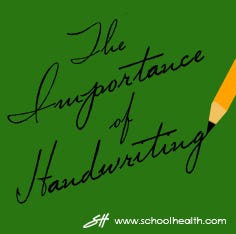The Importance of Handwriting
by Nancy Lafayette, OT
 As technology advances, so does the way we talk and write. The idea that technology is leading to the demise of the essential skill of handwriting is both valid and persistent.Learning how to write is more than just holding a pencil; it is a building block to learning. Handwriting helps with memory, improves expression, and supports fine motor skill development.
As technology advances, so does the way we talk and write. The idea that technology is leading to the demise of the essential skill of handwriting is both valid and persistent.Learning how to write is more than just holding a pencil; it is a building block to learning. Handwriting helps with memory, improves expression, and supports fine motor skill development.
Some would argue that the growth of computers, smart phones, and other mobile devices have rendered handwriting useless. However, handwriting skills are more important than ever. Studies show that the sequential finger movements necessary for handwriting can activate the region of the brain involved in thinking, memory, and language.
In the early childhood setting, the activities many children perform with their hands are actually prewriting skills designed to improve visual motor function, visual perception (space awareness), hand/eye coordination, and motor control.
Tips for helping children
- Tracing shapes and horizontal and vertical lines is great practice for children.
- Increase hand strength with activities like wheelbarrow walks, hanging from rings or bars, tug-of-war, and animal walks.
- Increase hand/eye coordination by letting them hold pencils or crayons.
- Strengthen children’s pinch by doing activities like picking up small beads or beans. Art activities, like painting with small pieces of sponge, can also help strengthen a child’s pinch.
Serving children with special needs
Children with special needs may struggle to learn handwriting due to physical or neurological challenges. Some children may not have developed the motor coordination or physical skill needed to use a pen, pencil, or marker and the ability to stay between the lines. Others have perceptual difficulties that causes them to see the shape of the letters differently. Sometimes these children may not have the confidence or understanding to copy the individual letters.
There are many high-tech and low-tech solutions for helping a child learn to write. Mobile devices are the most common types of being utilized for children with special needs. There are numerous mobile apps available that mimic the hand/eye coordination activity of handwriting. Technology should not be a replacement for handwriting, but should be used as a tool to keep children learning and engaged.
Whether the child has special needs or not, getting them to practice prewriting skill is important to their educational growth.
School Health would like to thank Nancy LaFayette, OT for her contribution to our blog.